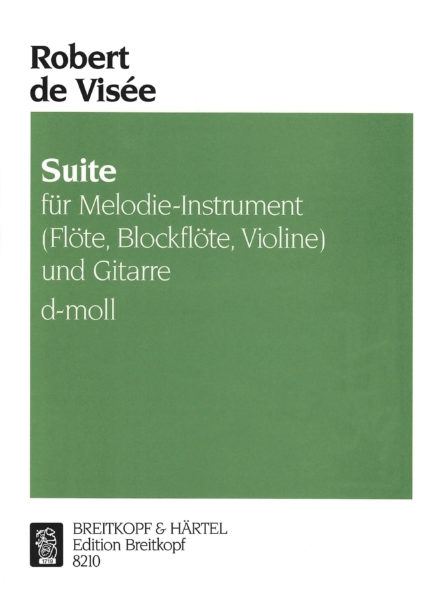Robert de Visée (~1650–1725) Suite d-moll
herausgegeben von Ferdinand Uhlmann [Fl(Blfl,Vl)Git]
aus Livre de Piéces pour Ja Guitarre, Paris 1686
16 Seiten | 23 x 30,5 cm | 89 g | ISMN: 979-0-004-17550-7 | Broschur
Robert de Visée (1650? bis 1725?), Gitarrist, Theorbist, Sänger und Komponist, wirkte am Hofe Ludwig des XIV. als Musiker und Gitarrenlehrer des Königs. Er war in musikalischen Kreisen hoch geschätzt und veröffentlichte unter dem Privileg des Königs drei Werke im Druck. 1682 und 1686 erschienen in Paris je ein Buch mit insgesamt 12 Suiten und einigen Einzelsätzen für fünfchörige Barockgitarre in französischer Tabulatur. An den Schluss dieser beiden Bücher setzte de Visée einen Teil seiner Gitarrenwerke in französischem Violinschlüssel mit beziffertem Bass: „um diejenigen zu befriedigen, die meine Werke auf andern Instrumenten spielen möchten“ – wie er in den Anweisungen zu seinen Gitarrenbüchern angab.
Eine Wiedergabe der Solowerke de Visées ist nur auf einer zehnchörigen Barockgitarre mit der damals üblichen Stimmung möglich. Die Bearbeitung für unsere sechssaitige Gitarre erfordert oft starke Eingriffe in den Satz. Den Originalklang der Barockgitarre kann die sechssaitige Gitarre nicht immer vermitteln. Deshalb hat der Herausgeber – entsprechend de Visées Anweisungen – sich entschlossen, die vorliegende Suite aus dem zweiten Gitarrenbuch (1686) für ein Melodie-Instrument mit Gitarren-Continuo einzurichten.
Als Vorlage diente die Notenschlüsselfassung. Für die Harmonien und Verzierungen (in Klammern) wurde stellenweise auch die Tabulatur berücksichtigt. Ein bezifferter Bass wurde im allgemeinen für ein beliebiges Begleitinstrument (Tasten- oder Zupfinstrument, oft mit Bassverstärkung durch Violoncello oder Fagott) gesetzt. Deshalb lässt sich eine Ausführung auf der modernen Gitarre ohne weiteres vertreten.









